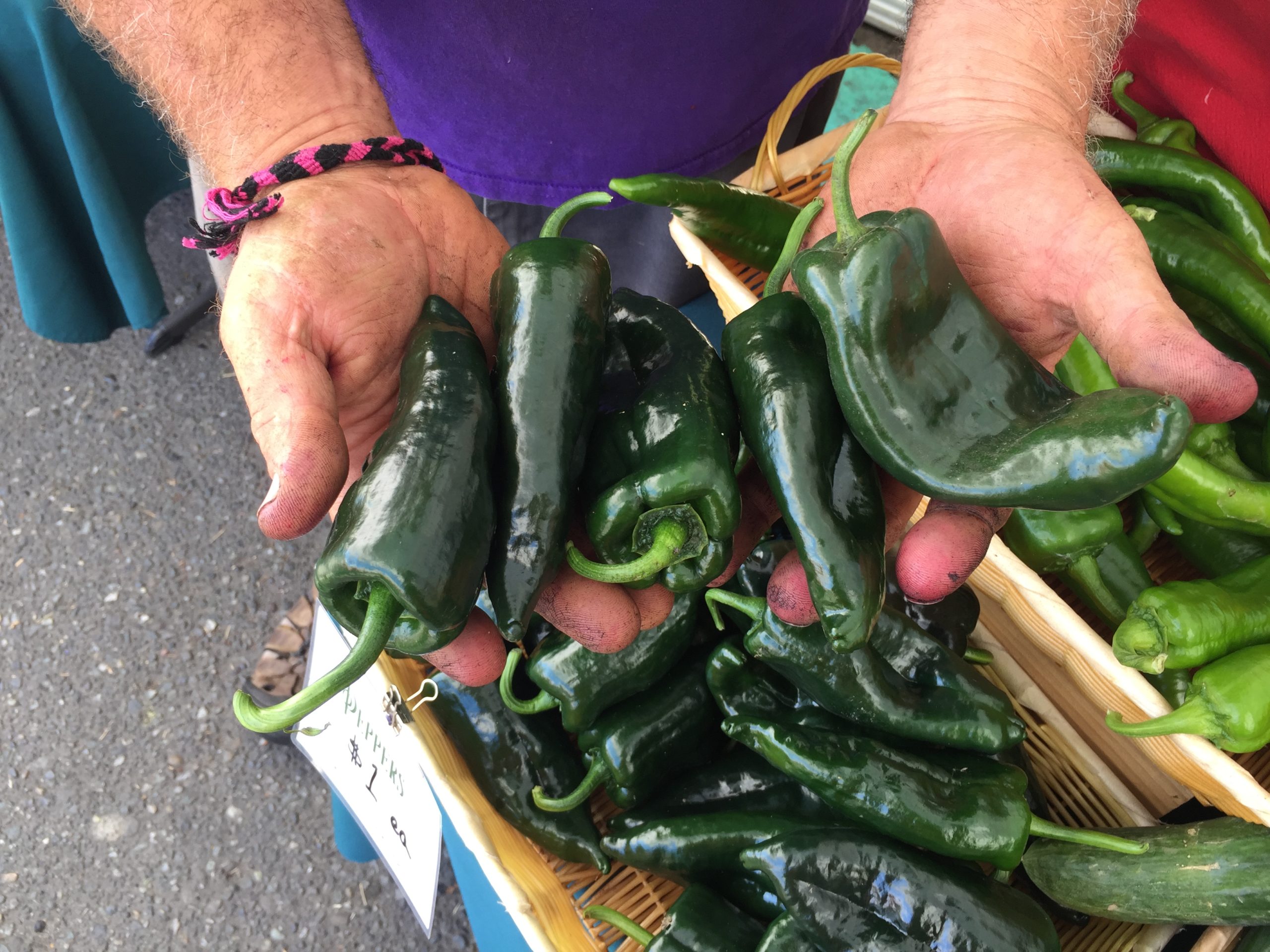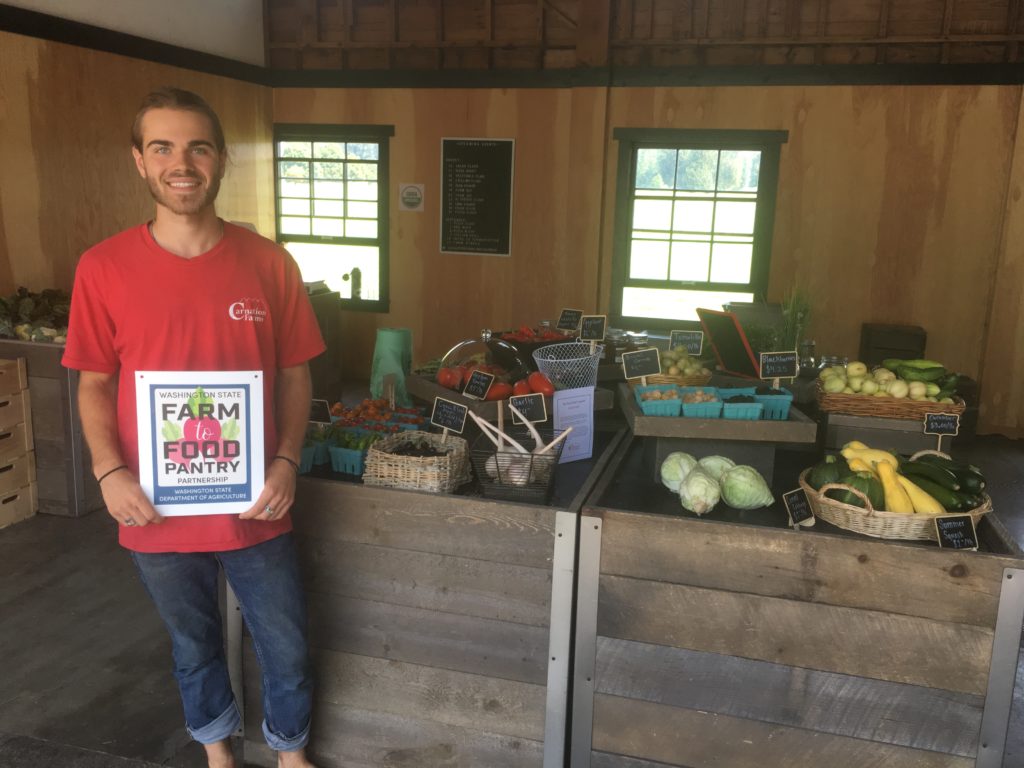Farm to Food Pantry
Apply Now!
Harvest Against Hunger (HAH) is calling for applications from hunger relief organizations, tribes, and public agencies to implement the Farm to Food Pantry (F2FP) program in their region.
The F2FP program, a partnership between WSDA and HAH founded in 2014, helps strengthen community-based food systems while increasing the viability and success of both agricultural producers and hunger relief organizations. The primary goal of the F2FP program is to support local small-scale farmers while increasing the quantity and variety of nutritious foods available from food assistance providers, improving access to healthier, culturally relevant food choices for Washingtonians experiencing nutritional insecurity.
Additional Information
Getting fresh produce into the food assistance system is an important part of hunger-relief efforts across Washington.
Harvest Against Hunger partners with the Washington State Department of Agriculture (WSDA), Harvest VISTA host sites, farmers, food pantries, and local funders to expand the Farm to Food Pantry initiative that launched in 2014. The pilot began in response to a series of grower roundtables with small-scale farmers around WA, which indicated that it wasn’t always financially feasible for small farms to donate to food pantries, but funding to create a purchasing relationship could offer a valuable opportunity to enhance the local small farm landscape.
Results from each year since show that buying directly from a local farmer will increase the variety, nutrient density, and availability of local crops in food pantries, thus improving access to healthier food choices for families and individuals experiencing nutritional insecurity. These direct purchasing contracts dramatically strengthen the bond between farmers and hunger-relief programs. Results continue to show that if a farmer has a strong relationship with a local food pantry, they are significantly more inclined to make additional produce donations through either gleaning or post-harvest. F2FP has fostered relationships across local food pantries, farmers markets, farm service organizations, nutrition education programs, and more!
We’ve compiled reports from previous seasons in our online Produce Recovery Guide. Recommendations from previous pilot programs show that sites (or “Sub-Agencies”) should consider creating early-season contracts with growers, making payments before delivery (“seeds in the ground”), and engaging multiple farms. By taking these steps, the sites should be able to grow new relationships and strengthen the existing ones that they have with local farms.
See the F2FP Overview for detailed information about initiative eligibility, procedures, deliverables, and resources.
Frequently Asked Questions
● Be a public agency, a tribe or tribal organization, or a 501(c)(3) nonprofit agency.
● Be currently registered as a nonprofit agency/corporation with the Secretary of State Office in Washington, unless a federally recognized tribe. If a nonprofit agency, have had IRS 501(c)(3) nonprofit status for at least one year prior to the beginning date of the sub-agreement date.
● Be registered and “searchable” in the System for Award Management (SAM) with a valid UEI Number.
Requirements for data reporting, maintaining organization eligibility, and administrative procedures are outlined in the Guidance Document. After successful applicants are selected, we will send a poll to determine a day/time for monthly virtual cohort meetings that fit most of the agency coordinators’ schedules; we ask that F2FP coordinators attend at least 50% of these meetings.
Ultimately, we expect sub-agencies to engage with F2FP as more than just a funding source, but as a foundation to develop sustainable, mutually beneficial partnerships with local small-scale farms that engage your stakeholders in supporting equitable local food systems as well. Local food systems are all about relationships! Communication is key–especially with farms, so that they’re clear on what/how much produce you want delivered and when. We hope that you promote your local farm partnerships in your food distribution, on social media, and other outreach.
Farms must be licensed with the Washington State Dept. of Revenue (see this list for exceptions, which farmers would need to attest to). Sub-agencies are expected to work with small-scale farms (~ <100 acres) located within their service area or adjacent counties.
HAH sends funding to the sub-agency, which then pays the farms directly.
WSDA has seasonality charts showing what fruits, herbs, vegetables, and legumes are in season in WA throughout the year. We expect agencies to talk with farm partners about the produce they’re planning to grow for the year and when it will be available.
It depends on capacity! In HAH’s programs, it has most commonly been the farms delivering — for example, it might be convenient for the farm to deliver on their way to/from a delivery to a farmers market, CSA pick-up site, or restaurant customer. In rural areas, agencies may arrange a more central pick up location. It is up to sub-agencies to work with their farm partners to determine the most feasible plan.
Pricing varies by region, so it may help to ask a farm local to you that already wholesales about the prices on their “fresh sheets.” If you’d be working with a direct-to-consumer farm that’s new to wholesaling, we’ve seen some F2FP agencies around WA identify 50% of a farmer’s market price as a standard for a high-end wholesale market. Farms may or may not be able to offer a discounted rate for food assistance customers or for produce that was unsold at the farmers market that day — we recommend that both parties be flexible, but F2FP aims to support farms with fair market prices.
See our list of current agencies on this page below! Depending on available funding and the applicant pool, there may be more than 1 sub-agency in some counties. We will prioritize applicants serving areas that have not previously been reached by F2FP.
In Farm to Food Pantry 2023
2024 F2FP Report
Click here to view and download the full 2024 Farm to Food Pantry Report.
The report highlights activities from of the participating Lead Agencies, as well as spotlight information on new strategies and programs that were developed to better connect participating sites with local farmers.
The report also provides qualitative and quantitative information gleaned from both farmers and food pantries that partnered with Lead Agencies, including:
- Counties served
- Key findings
- Types of crops purchased and donated (per site)
- Pounds of crops purchased and donated (per site)
- Feedback from farmers and food pantries
- Recommendations for future project development
- Opportunities for sharing the initiative across additional areas
Click here to view and download the full 2023 Farm to Food Pantry report.
Contracting and Program Models
Specific program models used (e.g. scheduled pre-harvest purchase vs. ad-hoc post-harvest purchase) are determined by the host site and will be based on needs of the local food access program and their farm partners. It is important that the host site creates a balance between increasing and diversifying the availability of fresh local food for lower-income individuals, while also supporting the viability of local small-scale agriculture. These relationships are often flexible enough that farmers are able to sell everything they grow in a season.

Testing, Learning, Growing

Although F2FP began in 2014, we will still approach it as a pilot by encouraging participants to develop new models in close partnership with their farm, pantry, and community partners. Exploring and sharing new ideas and projects help us and the F2FP agency network to develop a deeper understanding of what makes partnerships effective and beneficial for all parties. What works well in some communities may not work in other areas where farming practices and growing seasons are different, or food bank needs are more varied.
Additionally, in 2021, WSDA began also contributing USDA Farm to Food Bank funding to F2FP for purchasing gleaning supplies for Regional Agencies serving food pantries in TEFAP. Read more details about the impact on the WSDA website!
We believe the ongoing expansion of the F2FP initiative is an effective way to support diversified small-scale agriculture through food access networks and look forward to continuing to develop this winning formula for hunger relief and food system localization around Washington.
F2FP Locations
We are pleased to announce our 2023-24 F2FP initiative partner sites:
- Arlington Community Food Bank
- Blue Mountain Action Council
- Bonney Lake Community Resources
- Clark County Food Bank
- Coastal Harvest
- Community Action Center, Whitman
- Community Action of Skagit County
- Council on Aging & Human Services
- Darrington Food Bank
- Eatonville Family Agency
- Emergency Food Network
- FareStart
- Farmer Frog
- Feeding Feasible Feasts
- Ferndale Food Bank
- Food for All, Catholic Charities Spokane
- Friday Harbor Food Bank
- Good Cheer Food Bank
- Helping Hands Food Bank, Sedro-Woolley
- Hopelink
- Hunger Intervention Program
- Kitsap Conservation District
- Lifelong (Chicken Soup Brigade)
- Lopez Island Family Resource Center
- Making A Difference Foundation
- Nourish Pierce County
- O.I.C. of Washington
- Okanogan County Community Action Council
- Olympic Community Action Programs
- Orcas Island Food Bank
- Othello Food Bank
- Rainier Valley Food Bank
- N.E.W. Hunger Coalition
- SW WA LULAC Foundation
- Thurston County Food Bank
- Upper Valley MEND
- WSU Extension, Clallam & Jefferson
- WSU Extension, Lewis / Lewis County Food Bank Coalition



